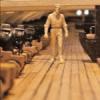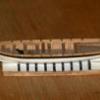-
Posts
511 -
Joined
-
Last visited
Reputation Activity
-
 pompey2 got a reaction from thibaultron in Tweezers - Japanese vendor Kaneshin
pompey2 got a reaction from thibaultron in Tweezers - Japanese vendor Kaneshin
They do some great tweezers, I will be getting a couple certainly.
Nick
-
 pompey2 got a reaction from mtaylor in Tweezers - Japanese vendor Kaneshin
pompey2 got a reaction from mtaylor in Tweezers - Japanese vendor Kaneshin
They do some great tweezers, I will be getting a couple certainly.
Nick
-
 pompey2 got a reaction from Canute in Tweezers - Japanese vendor Kaneshin
pompey2 got a reaction from Canute in Tweezers - Japanese vendor Kaneshin
They do some great tweezers, I will be getting a couple certainly.
Nick
-
 pompey2 reacted to michael mott in Holiday Harbor by popeye the sailor - 1:20 scale - multi build
pompey2 reacted to michael mott in Holiday Harbor by popeye the sailor - 1:20 scale - multi build
Nice pair of knockers on the doors Denis they almost look like lions heads, now that would be neat.
Michael
-
 pompey2 got a reaction from mtaylor in Second Planking
pompey2 got a reaction from mtaylor in Second Planking
Sanding sticks can also help a bit, you can be gentler with your sanding
Glue sandpaper strips to a backing strip about 1/2" x 6"
-
 pompey2 got a reaction from Canute in Second Planking
pompey2 got a reaction from Canute in Second Planking
Sanding sticks can also help a bit, you can be gentler with your sanding
Glue sandpaper strips to a backing strip about 1/2" x 6"
-
 pompey2 reacted to hornet in double planking a hull
pompey2 reacted to hornet in double planking a hull
Jbshan, you mention `plank separation' in your post regarding single layer of planking. My first build (over 30 years ago) was the Aeropiccola `Golden Hind.' It was single planked. The book `Period Model Boat Manual' which I bought at the time (don't know if it is still in print or not) recommended `caulking ' the inside of the hull to prevent this happening. This was done by layering bandage dressing `gauze' into the interior of the hull and coating with thinned wood glue. It was a similar method to fibreglassing. I used the method and after 30 years still no cracking or plank separation. See pics below.
extract from `Period Model Boat Manual'
Hull of the `Golden Hind' 33 years after construction (no plank separation)
-
 pompey2 got a reaction from dafi in HMS Victory 1805 by pompey2 - FINISHED - Caldercraft - 1:72
pompey2 got a reaction from dafi in HMS Victory 1805 by pompey2 - FINISHED - Caldercraft - 1:72
Time for an update, if fact long overdue.
First some of the Bowsprit rigging.
Doing the Jibboom horses and manropes.
The martingales.
And Bobstays.
And the BS Shrouds.
I will split up my update posts into common sections.
Nick
-
 pompey2 got a reaction from Old Collingwood in HMS Victory by Jonesey - Corel - Scale 1:98
pompey2 got a reaction from Old Collingwood in HMS Victory by Jonesey - Corel - Scale 1:98
Before you glue in the bulkheads work out how you will keep them square whilst drying.
If they are out then pretty much everything else is.
Some people use lego blocks (surprisingly square) or you can make up some braces to hold them.
It's a good idea to have all of that detail prepared before any gluing.
Nick
-
 pompey2 got a reaction from Seventynet in HMS Victory 1805 by pompey2 - FINISHED - Caldercraft - 1:72
pompey2 got a reaction from Seventynet in HMS Victory 1805 by pompey2 - FINISHED - Caldercraft - 1:72
Time for an update, if fact long overdue.
First some of the Bowsprit rigging.
Doing the Jibboom horses and manropes.
The martingales.
And Bobstays.
And the BS Shrouds.
I will split up my update posts into common sections.
Nick
-
 pompey2 got a reaction from dafi in HMS Victory 1805 by pompey2 - FINISHED - Caldercraft - 1:72
pompey2 got a reaction from dafi in HMS Victory 1805 by pompey2 - FINISHED - Caldercraft - 1:72
Final instalment for the time being
The lanterns now full fitted.
And how they look with the lamps lit.
Then a bunch of photos showing other views with the lighting switched on.
I'm pretty pleased with how the lighting worked out I must say, especially the three lanterns.
That's it for now, thanks for looking
Nick
-
 pompey2 got a reaction from dafi in HMS Victory 1805 by pompey2 - FINISHED - Caldercraft - 1:72
pompey2 got a reaction from dafi in HMS Victory 1805 by pompey2 - FINISHED - Caldercraft - 1:72
And a few more.
Now ready to start raising the Yards.
But I considered that once the rigging was all done, cleaning off the dust would be more difficult.
So decided to have a good spring clean before starting Yards.
I use a piece of rigid plastic tube about 1/4" dia taped into the end of a standard vacuum cleaner.
It still gives a pretty good suction.
Then I use a soft brush to brush off the dust with the tube right up behind.
So this is where I stand before the Yards and once cleaned up.
And so onto the first yard, the Fore Mast Yard.
held with a pin and a small drop of epoxy to the mast.
That's the lot for now
Thanks for dropping by
Nick
-
 pompey2 got a reaction from Cast Off in how to work with teeny blocks???
pompey2 got a reaction from Cast Off in how to work with teeny blocks???
Richard
This is the Jig I use.
It is good for blocks, dead eyes, rigging hooks, eyes and just loops.
I clamp the base to the desk.
Then use a modified clothes peg, push a long pin through holes in the peg and the hole in the block.
Then the peg fits into the base. There is a 'dowel' on the peg and a hole for the pin.
Thread is fed through around the block, caught with a clip and an elastic band tensions the thread.
I then seize the number of turns I want using the traditional ‘trapped loop’ method.
I pull the end of the thread through the loop and pull out the loop. Push the siezing up tight to the block.
Take out of jig, paint with 50/50 PVA and trim when dry.
I'm sure some will think this overkill.
But I have done hundreds of blocks (even the smallest of sizes), loops, eyes etc. so have gotten pretty slick.
And I love the way the it looks.
Nick
-
 pompey2 got a reaction from javajohn in how to work with teeny blocks???
pompey2 got a reaction from javajohn in how to work with teeny blocks???
Richard
This is the Jig I use.
It is good for blocks, dead eyes, rigging hooks, eyes and just loops.
I clamp the base to the desk.
Then use a modified clothes peg, push a long pin through holes in the peg and the hole in the block.
Then the peg fits into the base. There is a 'dowel' on the peg and a hole for the pin.
Thread is fed through around the block, caught with a clip and an elastic band tensions the thread.
I then seize the number of turns I want using the traditional ‘trapped loop’ method.
I pull the end of the thread through the loop and pull out the loop. Push the siezing up tight to the block.
Take out of jig, paint with 50/50 PVA and trim when dry.
I'm sure some will think this overkill.
But I have done hundreds of blocks (even the smallest of sizes), loops, eyes etc. so have gotten pretty slick.
And I love the way the it looks.
Nick
-
 pompey2 got a reaction from Canute in how to work with teeny blocks???
pompey2 got a reaction from Canute in how to work with teeny blocks???
Hi Sam
yeah it's exactly that.
Nick
-
 pompey2 got a reaction from Mirabell61 in how to work with teeny blocks???
pompey2 got a reaction from Mirabell61 in how to work with teeny blocks???
Richard
This is the Jig I use.
It is good for blocks, dead eyes, rigging hooks, eyes and just loops.
I clamp the base to the desk.
Then use a modified clothes peg, push a long pin through holes in the peg and the hole in the block.
Then the peg fits into the base. There is a 'dowel' on the peg and a hole for the pin.
Thread is fed through around the block, caught with a clip and an elastic band tensions the thread.
I then seize the number of turns I want using the traditional ‘trapped loop’ method.
I pull the end of the thread through the loop and pull out the loop. Push the siezing up tight to the block.
Take out of jig, paint with 50/50 PVA and trim when dry.
I'm sure some will think this overkill.
But I have done hundreds of blocks (even the smallest of sizes), loops, eyes etc. so have gotten pretty slick.
And I love the way the it looks.
Nick
-
 pompey2 got a reaction from mischief in CA for rigging
pompey2 got a reaction from mischief in CA for rigging
Agree, watered down PVA for rigging.
You do see lots of comments using CA to fix a stopper knot.
In that case even a later fracture is unlikely to be a problem so I do use it that way sometimes.
And of course to create a 'needle' for threading
Nick
-
 pompey2 got a reaction from avsjerome2003 in Art of period shipbuilding
pompey2 got a reaction from avsjerome2003 in Art of period shipbuilding
In a forest grown for ship making often the shapes were made by planting saplings adjacent to the trunks.
Put a few saplings on one side and the main trunk would begin to swing away in a search for light.
Much later put saplings on the other side and you get a 'bend' suitable for a knee.
-
 pompey2 got a reaction from JesseLee in Design and Build a Custom Work Station
pompey2 got a reaction from JesseLee in Design and Build a Custom Work Station
I never did get back to show the finished article.
But it all went to plan and I have been using it for a few months.
It does help keep my workbench clear of debris but I still have my hand tools close at hand.
Here are some photos.
The tool tray that sits on the top
The tray lifts off to access a cutting mat below.
It has some fittings to hold the little jig I use for seizing blocks etc.
And the whole thing is low enough to roll under my workbench to keep things tidy when I'm done.
Nick
-
 pompey2 got a reaction from Canute in HMS Victory by Jonesey - Corel - Scale 1:98
pompey2 got a reaction from Canute in HMS Victory by Jonesey - Corel - Scale 1:98
Before you glue in the bulkheads work out how you will keep them square whilst drying.
If they are out then pretty much everything else is.
Some people use lego blocks (surprisingly square) or you can make up some braces to hold them.
It's a good idea to have all of that detail prepared before any gluing.
Nick
-
 pompey2 got a reaction from hollowneck in how to work with teeny blocks???
pompey2 got a reaction from hollowneck in how to work with teeny blocks???
Richard
This is the Jig I use.
It is good for blocks, dead eyes, rigging hooks, eyes and just loops.
I clamp the base to the desk.
Then use a modified clothes peg, push a long pin through holes in the peg and the hole in the block.
Then the peg fits into the base. There is a 'dowel' on the peg and a hole for the pin.
Thread is fed through around the block, caught with a clip and an elastic band tensions the thread.
I then seize the number of turns I want using the traditional ‘trapped loop’ method.
I pull the end of the thread through the loop and pull out the loop. Push the siezing up tight to the block.
Take out of jig, paint with 50/50 PVA and trim when dry.
I'm sure some will think this overkill.
But I have done hundreds of blocks (even the smallest of sizes), loops, eyes etc. so have gotten pretty slick.
And I love the way the it looks.
Nick
-
 pompey2 reacted to Tadeusz43 in Art of period shipbuilding
pompey2 reacted to Tadeusz43 in Art of period shipbuilding
Rigging
Standing rigging Part 1
Channels and chain plates
Channels was installed on ships from the end of 15th century up to half of the 19th century.
It was the place of securing the lower ends of the shrouds and sometimes the backstays.
The lower deadeyes were attached to the hull by iron chains or rods called chain plate.
Neff Victoria
Vasa Halve Maen
Amsterdam
Batavia
Bounty
Gotheborg
Etile du Roy ( ex Grand Turk)
Shtandadrt
Victory
Jylland
Warrior 1860
Tadeusz
-
 pompey2 reacted to GuntherMT in General / organisation of wood
pompey2 reacted to GuntherMT in General / organisation of wood
So I'll go one step further for those that still seem to think that I should 'collect my own wood' rather than purchasing what I need.
I have exactly zero interest in doing that. I like building models. I have no interest in acquiring the large tools needed to break down the parts of a tree into piles of wood that have to sit in storage for years before I can use it for modeling ships.
This is a hobby that I enjoy, and wood harvesting, cutting, and aging is not a hobby that I have an interest in.
For some people those are two facets of the same hobby. For me, that's like telling someone who makes plastic models that they need to make their own plastic and pour their own molds. It's two completely separate hobbies that just happen to flow one into the other, and in my case (and I'm sure the vast majority of ship modelers) that first hobby just isn't an interest for me.
If you think that my models are 'flat' or not 'artistic' or whatever because of that, well, that's perfectly fine, because I'm not building my models for you, I'm building my models for me, and I'm perfectly fine with buying my 'fake' boxwood or whatever else I deem to look nice for the model that I'm building.
-
 pompey2 got a reaction from mtaylor in HMS Victory re-paint
pompey2 got a reaction from mtaylor in HMS Victory re-paint
The UK ran a documentary piece on the TV recently.
they interviewed the guy in Leicester and showed how they established the details etc.
Nick
-
 pompey2 got a reaction from robert22564 in HMS Victory by Rich.F - FINISHED - Caldercraft - Scale: 1/72
pompey2 got a reaction from robert22564 in HMS Victory by Rich.F - FINISHED - Caldercraft - Scale: 1/72
Hi Rich
Your Vic is coming on great guns.
The question you asked - yes it is the Catheads that go on there.
Here's photo's of the assembled bits (great fun that little assy) and in position.
Keep up the good work
Nick











.jpg.d84ec4dad1d7791e855dca06210ab6f3.thumb.jpg.f45209242e851d4409eca1a09293165b.jpg)
